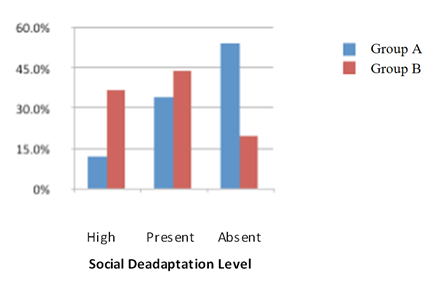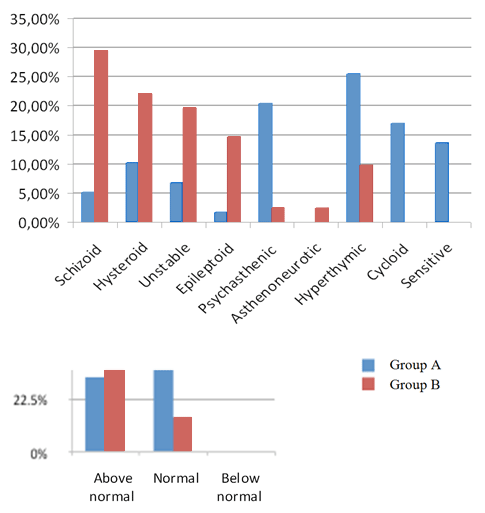

Volume: 4, Issue: 1
1/04/2012


1/04/2012
DESCRIPTORS: computer games addiction, psychological and social factors, prevention and correction patterns, patho-characteristic diagnostic questionnaire, social desadaptation, socialization, personality accentuations.
SYNOPSIS: The article presents the description and the results of a recent doctorate research with the focus towards how computer games addiction starts and develops, and also how to develop efficient prevention and correction patterns. The author also shows how to determine primary factors that contribute to increased addictive or adequate types of interaction with a computer game.
Introduction
Computer Games Addiction, which we define as a type of deviant behavior featuring growing inclination towards retreat from reality by means of changing one’s psychological condition by constantly focusing on active interaction with computer games or other users via such software, has currently become one of the most urgent problems of education and psychology throughout the world.
Computer games addiction is known to be caused by psychological and social factors. The first are determined by psychological and personality-shaping peculiarities of teenagers (neuro-psychic frailty, pronounced character accentuations, behavioral response) and specific disturbances in socialization. The second are influenced by social environment and conditions interfering with the realization of various behavioral strategies. In order to better understand how computer games addiction starts and develops, it is necessary to conduct a thorough research of these peculiarities. The research will enable us not only to understand the causes of such addiction but also how to develop efficient prevention and correction patterns as well as determine which other factors contribute (under similar conditions) to increased addictive or adequate types of interaction with a computer game.
Overview of similar research
The analysis of similar research in worldwide psychological and pedagogical practice made it possible to distinguish two groups of teenagers’ specific characteristics. The first group involves research relating to a teenager’s personality. Scientists point out specific value orientation features. Thus, computer gamers and gamblers demonstrate a less developed range of values [3; 7]. There is a higher number of affective personalities among computer addicts with prevalence of depression and obsessive-compulsive disorders [8; 17]. Computer addictive teenagers are more likely to suffer from frequent depressions with a higher risk of suicide [2; 6]. Applying Eysenck Personality Inventory to study human personality, Y. Amichai-Hamburger found prevalence of introversive personalities among computer addicts. He also discovered that addicts tend to have the feeling of loneliness which they try to suppress by active use of Internet [1]. S. Caplan distinguished the following specific features of computer addict’s personality: depression, loneliness, self-consciousness and false pride [4].
Similar research publications have recently appeared in Russia. For instance, when studying the personality of Internet-addicts, F.A. Saglam points to a significant discrepancy between teenagers’ real and ideal self [19]; M.V. Bredikhina draws attention to high levels of anxiety and motivational aggression [12]. The most interesting research related to our subject was conducted by a team headed by A. Egorov. The research attempted to identify special personality features of teenage Internet-addicts [13]. It was found that schizoid, hysteroid and labile types of accentuations prevailed among addicts.
The second group included research focusing on social issues of teenagers susceptible to computer games addiction. Earlier research indicated inclination to lack of social adaptation and lower learning motivation. Computer games addicts are characterized by social isolation [4; 5] and inadequate self-identification [9]. A.Egorov observed that addicts are more timid and unsociable; they adhere to conformal types of social behavior [13]. Saglam revealed a low level of communicative and organizational skills in Internet addicts [19], Maksimov spoke of computer addicts’ low level of play activity [16].
Summarizing the results of various research, N.V. Chudova distinguishes the following signs of computer addiction: difficulty in assuming one’s own physical self (one’s own body), difficulty in face-to-face communication (withdrawal), tendency to intellectualization, feeling of loneliness and lack of mutual understanding (probably related to difficulty in interacting with the opposite sex), low aggressiveness, emotional tenseness and a certain inclination to negativism, presence of at least one frustrative need, independence seen as a special value, undifferentiated and overrated or even unrealistic perceptions of the ideal self, lower self-esteem, tendency to avoid problems and responsibility [20].
Research objectives
To define special personality and social features of teenagers susceptible to computer games addiction, we conducted an empirical research which included the following objectives: to determine correlation between character accentuation types and social maladjustment inclinations, on the one hand, and the types of teenager’s interaction with a computer game, on the other; to identify characteristic personality accentuation types of teenagers inclined to building addictive types of interaction with computer games; to determine correlation between selected types of interaction with computer games and teenage socialization patterns; to define correlation between anxiety level and selected types of interaction with computer games; to define and validate social and pedagogical conditions under which a computer game may serve as a facilitating process of teenagers’ socialization; to define and validate social and pedagogical conditions under which a computer game may become a factor contributing to formation and development of computer games addiction.
Research techniques and respondents
The research pool included one hundred teenagers of both genders, ages from 10 to 16. To identify a high-risk group of teenagers susceptible to computer games addiction we applied Dr. Kimberly Young’s computer addiction susceptibility questionnaire [10] and deviant behavior susceptibility measurement technique [17]. To determine special personality and social features of teenagers (both genders) we used the following diagnostic instruments: patho-characteristic diagnostic questionnaire [15] which made it possible to identify types of character accentuations and risk levels of social desadaptation, a technique to assess levels of students’ personality socialization [18], the Buss-Durkee Inventory to measure hostility and aggression [14], and the subjective control level measurement technique [11].
Results
During the first stage of research based on the results of the computer games addiction susceptibility questionnaire and deviant behavior susceptibility measurement technique (“deviant behavior susceptibility” scale), respondents were divided into two groups: teenagers not inclined to computer games addiction and a high-risk group. The high-risk group constituted the teenagers who exceeded 50 points on the above deviant behavior susceptibility scale and also exceeded 50 points according to the computer games addiction susceptibility questionnaire.
The computer games addiction susceptibility questionnaire showed the following results: 59% build adequate types of interaction with a computer game (less than 50 points); 37% are teenagers with frequent problems caused by excessive use of computer games who tend to build addictive types of interaction with a computer game (50-79 points); 4% have significant problems because of computer games and thus building primarily addictive types of interaction with a computer game (over 80 points).
According to the deviant behavior susceptibility scale, the respondents ranged as follows: 3% revealed psychological need in addictive conditions (over 70 points); 29% were inclined to avoid reality by means of changing their psychological condition, tended to illusory-compensatory way to solve personal problems (50-70 points); 68% of respondents did not reveal strongly pronounced tendencies, they demonstrated good social control of behavioral response (less than 50 points).
As a result, the researchers divided the respondents into two groups. Group A consisted of teenagers who had no risk of developing addictive behavior, were not inclined to computer games addiction but built adequate patterns of interaction with a computer game. This Group constituted 59% of the total number. Group B included teenagers experiencing risk of developing addictive behavior, inclined to computer games addiction and building addictive patterns of interaction with a computer game. This Group constituted 41% of all respondents.
The second stage of research involved the patho-characteristic diagnostic questionnaire that produced the following results: Group B is prevailed by schizoid (29.27%), hysteroid (21.95%), and unstable (19.51%) accentuation types. Less frequent are such types as epileptoid (14.63%) and hyperthymic (9.76%), and a few cases of asthenoneurotic and psychasthenic (2.44% each) types.
Prevailing types among teenagers of Group A are hyperthymic (25.42%), psychasthenic (20.34%), cycloid (16.95%), and sensitive (13.56%). Types of accentuations that prevail in Group B are less frequent in Group A: hysteroid (10.17%), unstable (6.78%), schizoid (5.08%), epileptoid (1.69%). Note that we have presented prevailing types of accentuations or those that were emphasized for the sake of respondent group comparison. In addition to that, analysis of research results made it possible to diagnose the social desadaptation level. Group B was prevailed by teenagers who had a certain level of social desadaptation (43.9%) and a high level of its manifestation (36.5%). 19.5% of respondents do not have such a risk. Among Group A teenagers, 33.9% reveal the risk of social desadaptation, the risk is high in 11.9%, and 54.2% do not have such a risk (see Illustration 1).
Illustration 1. Correlation of teenagers with prevailing types of accentuations and various levels of social desadaptation in Group A and Group B

Increased parameters on the drug and alcohol addiction susceptibility scale of Group B teenagers are the key characteristics to determine the risk of continued addictive behavior and validity of the above group classification. The above scale distribution results are as follows: 3.38% of Group A teenagers and 19.51% of Group B teenagers show a pronounced risk of drug and alcohol addiction, 28.81% of Group A teenagers and 43.9% of Group B teenagers demonstrate inclination to drug and alcohol addiction, and 67.79% of Group A respondents and 36.58% of Group B respondents do not reveal inclination to drug and alcohol addiction.

The Buss-Durkee Inventory showed higher hostility and aggression indexes in Group B compared to Group A (see Illustration 2).
The Subjective Control Level technique revealed prevalence of external life situations locus control in Group B teenagers (78.04%). Compare this to 20.34% of teenagers who feature this locus control in Group A.

Illustration 2. Teenagers’ hostility and aggression levels in groups A and B
During the third stage of research, the respondents were offered the students’ personality socialization measurement technique.
To validate the hypothesis that computer games may produce a positive effect on teenager socialization level and serve a facilitating function in this process, the research included the third group of respondents – Group C – which is equal to Group A in its number, age and gender. Based on interviews and conversations, the researches formed Group C out of teenagers who do not play computer games.
The table below presents the research results in the form of overall average figures of each group respondents’ values classified by four socialization criteria:
Criteria of socialization |
Group A |
Group B |
Group C |
Adaptability |
3,4 |
1,7 |
3,1 |
Autonomy |
3,2 |
2,1 |
2,9 |
Activity |
3,8 |
1,9 |
3,3 |
High morality |
2,6 |
2,2 |
2,8 |
The table shows that in all criteria, with the exception of high morality, values in Group C are lower than those of Group A. Overall average figures of socialization in Group A, as we can see, do not exceed 3 which may indicate a low level of socialization and reveal problems which teenagers face in the process of social adaptation and autonomy. When teenagers build addictive patterns of interaction with computer games, social adaptation processes are disrupted, socialization sphere is changing, a feeling of loneliness is increased, and self-esteem sphere is distorted - these conclusions are prompted by the low adaptability (1.7) and autonomy (2.1) values of Group B teenagers. We should also note lower socialization figures in practically all criteria of Group B. It proves the assumption that computer games may produce a positive effect on teenager socialization level provided there are certain conditions.
If we compare the results, we would come to a number of conclusions. The patho-characteristic diagnostic questionnaire results show obvious prevalence of teenagers with schizoid character accentuations in the high-risk group. It is explained by the fact that the key feature of schizoids is their tendency to avoid reality. In addition to difficulties in the process of socialization (specifically, these teenagers showed the lowest adaptability and activity values according to the socialization measurement technique), such accentuations may serve as a risk factor in computer games addiction development. A large number of hysteroids, who try to be constantly “in the limelight,” “in the center of attention,” may at first seem unusual because computer games addicts are typically reserved, hardly sociable, tending towards solitude and loneliness. However, comparing the patho-characteristic diagnostic data and the socialization measurement technique where teenagers of this accentuation type receive lower results, we may assume that in this case the computer games addiction develops in the compensatory way: when it is not possible for teenagers to attract attention in the real world, they try to do this in the virtual world.
Another fact seems to be of interest too. Among all teenagers of Group B, these are hysteroids and schizoids who have a greater attraction to online games. The unstable accentuation type is characterized by a relative lack of will. These very teenagers constitute the core of the external locus control group (as proved by the subjective control level measurement); they are always part of the high-risk group to develop various addictions. Among them, development of computer games addiction is based on grouping and passion reactions. For the epileptoid type with its dysphorias, the computer game is a space to realize affective bursts. Under the pressure of social environment, the epileptoids’ dysphorias are squeezed out into the world of computer games. Notably, such accentuation type teenagers are more likely to choose extremely violent games. They also have an overrated aggression and hostility level.
The second group shows prevalence of hyperthymic and psychasthenic personality accentuations. Hyperthymic teenagers have high values of social activity and autonomy. The large number of psychasthenics is explained by their characteristic absence of any inclination to deviant behavior. The majority of such teenagers prefer complex intellectual games, and the share of online gamers among them is extremely low. The cycloid accentuations teenagers are closer to others to the high-risk group. They prefer similar games as the Group A respondents while the cycloid accentuations teenagers have lower socialization values compared to other teenagers of Group B. However, due to the cycloid nature of their mood phases, they do not play long, often change games, and make long intervals. They do not build addictive types of interaction with a computer game.
Conclusions
This paper has discussed only one aspect of computer games addiction problem. It is currently very important to develop new and efficient preventive measures in various areas of life activity. The study of gamers and the nature of their interaction with computer games seems to be rather promising in relation to individualized prevention measures.
References
Druzin Vladimir Nikolayevich, [In Russian – Владимир Николаевич Друзин], PhD, Senior Lecturer, Department of Pedagogical Technologies, Yaroslav State Pedagogical University after Ushinsky, Yaroslavl, Russia.
Home | Copyright © 2025, Russian-American Education Forum